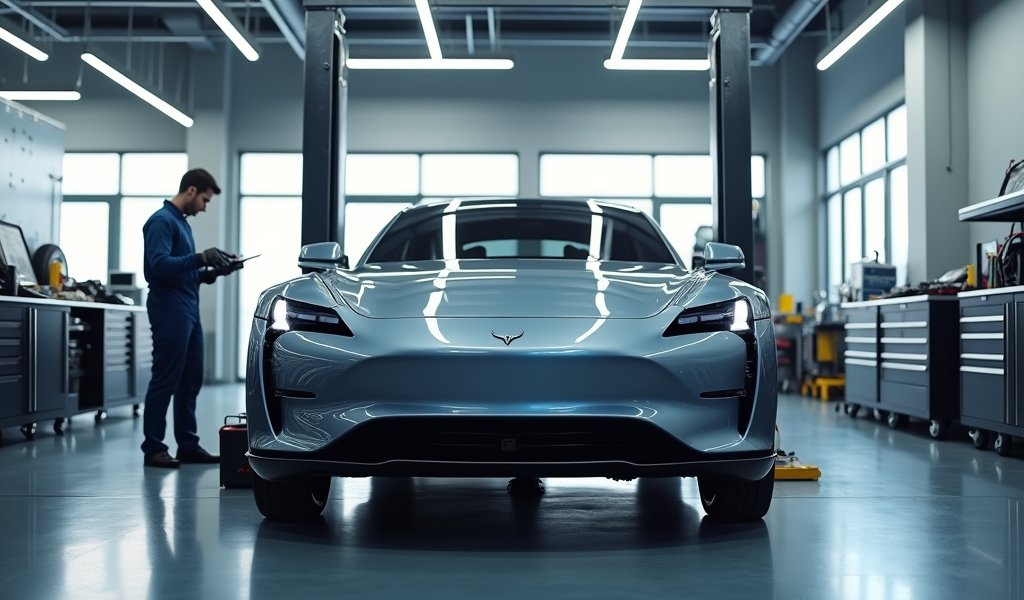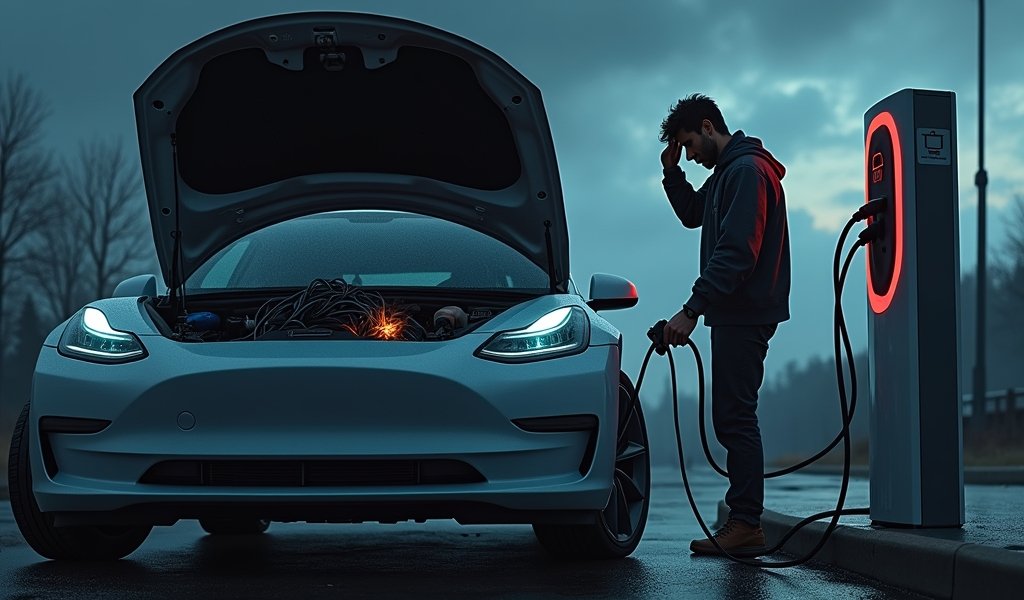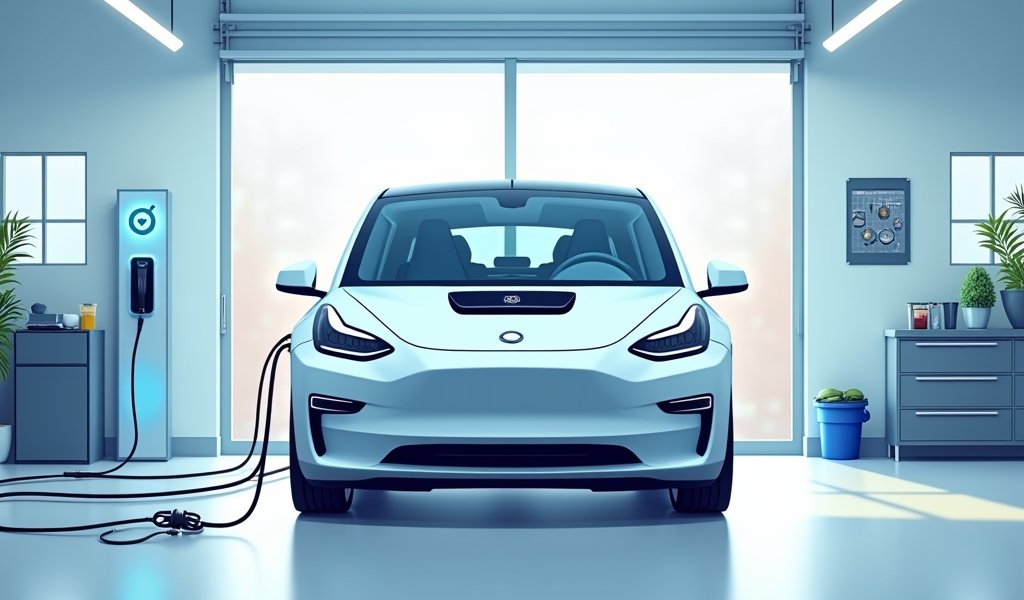Overview
Electric vehicle maintenance differs from traditional cars, focusing on six key areas: battery care (optimal charging between 20-80%), tire maintenance (more frequent rotation due to higher wear), brake system care (occasional “cleaning stops”), cooling system upkeep, software updates, and cabin maintenance. While EVs eliminate oil changes and require fewer overall maintenance visits, they demand specific attention to these systems to maximize performance, range, and longevity.
Table of Contents
- The Electric Revolution: A New Maintenance Paradigm
- Battery Care: Nurturing Your EV’s Lifeblood
- Tire Maintenance: Where the Rubber Meets the Road
- Brake System Care: Less Wear, Different Maintenance
- Cooling System Maintenance: Keeping Your EV’s Cool
- Software Updates: Your Car’s Digital Heartbeat
- Cabin and Filter Maintenance: Breathe Easy
- Conclusion: Embracing Your Electric Future
- Frequently Asked Questions
The Electric Revolution: A New Maintenance Paradigm
Have you noticed how electric vehicles have transformed from futuristic oddities to everyday companions on our roads? As a master technician with 15 years of hands-on experience with both conventional and electric vehicles, I’m here to tell you that while these silent road warriors don’t demand oil changes, they aren’t maintenance-free chariots of the future.
Think of your electric car as less like a traditional mechanical beast and more like a sophisticated computer with wheels. The maintenance isn’t necessarily harder—it’s just different. Like trading your grandfather’s pocket watch for a smartwatch, the care requirements have evolved rather than disappeared.
The good news? Your electric vehicle requires fewer maintenance visits than its gas-guzzling ancestors. No more oil changes every few thousand miles or timing belt replacements that cost more than your first car. Instead, we’re talking about a new set of priorities that keep your EV humming along efficiently.
Let me walk you through the six essential electric car maintenance tips I’ve gathered from years in the garage and thousands of EVs serviced. These aren’t just manufacturer recommendations—they’re battle-tested practices that will keep your electric chariot running at its peak for years to come.
Battery Care: Nurturing Your EV’s Lifeblood

If your car’s battery were a person, it would be the marathon runner of the vehicle—doing the heavy lifting day in and day out. And just like any athlete, how you train and recover matters tremendously for longevity.
Your charging habits are the single most influential factor in your battery’s lifespan. Fast chargers—while convenient when you’re in a pinch—are like sprinting: great occasionally, but not ideal for daily training. For everyday use, standard Level 2 charging is your battery’s best friend.
Here’s what 15 years of working with EV batteries has taught me about optimal charging patterns:
- Aim to keep your battery between 20% and 80% charged for daily driving
- Only charge to 100% when you actually need the full range (like before a road trip)
- Avoid letting your EV sit for weeks at either 0% or 100% charge
- If storing your vehicle long-term, leave it at about 50% charge and plug it in every month if possible
Temperature extremes can be as harsh on your battery as they are on you. Park in shaded or garage spots during heatwaves, and if possible, precondition your vehicle (warm the battery) before driving in frigid temperatures. According to research from the Department of Energy, extreme temperatures can temporarily reduce range by up to 40%.
Most modern EVs include sophisticated battery management systems that handle much of the heavy lifting, but they can’t control where you park or how you charge. Think of battery maintenance as a partnership between you and your car’s computer—work together, and your battery will thank you with years of reliable service.
Tire Maintenance: Where the Rubber Meets the Road
Electric vehicles have a secret that catches many first-time owners by surprise: they’re absolute tire devourers. Why? That instant torque you love so much combined with battery weight creates a perfect storm for tire wear. In my shop, we see EVs coming in for tire replacements up to 20% more frequently than their gas counterparts.
The rotation schedule for your EV isn’t just a suggestion—it’s essential preventive medicine. Mark your calendar for every 6,000-8,000 miles, or roughly twice a year for average drivers. Those few minutes on the lift can double your tires’ useful life.
Tire pressure isn’t just about safety; it’s about range. Underinflated tires are like trying to pedal a bicycle with flat tires—everything takes more energy. I recommend checking pressure monthly and before any long trip. Even 5 PSI below recommendation can reduce your range by 2-3%.
When it’s time for new rubber, look specifically for tires designed with EVs in mind. These tires feature:
- Lower rolling resistance formulations that maximize range
- Reinforced sidewalls to handle the additional torque and weight
- Noise-reducing designs (crucial in vehicles without engine noise to mask road sounds)
- Often, specialized weight ratings for heavier electric platforms
Don’t skimp on tires—they’re the only part of your sophisticated EV actually touching the road. Quality rubber isn’t just about performance; it’s about safety and efficiency.
Brake System Care: Less Wear, Different Maintenance
Imagine my surprise when I first started servicing EVs regularly and saw brake pads with 60,000+ miles looking nearly new! The regenerative braking system in your electric vehicle is like having an invisible helper slowing you down without touching the brake pedal. This marvel of engineering captures energy while slowing the car, recharging your battery instead of wearing down brake pads.
But this blessing comes with an unexpected challenge: brake components that rarely get used can develop problems. It’s like leaving a classic car in the garage too long—things start to seize up. Here’s what I recommend to my customers:
Every few weeks, find a safe, empty stretch of road and perform what we call “brake cleaning stops.” Apply your brakes firmly (but safely) several times in succession. This helps clear off any surface rust and keeps components moving freely. Think of it as joint exercises for your car.
Despite less frequent use, brake fluid still ages and absorbs moisture from the air. This happens regardless of how much you use your friction brakes. Schedule a brake fluid flush every 2-3 years, just as you would with a conventional vehicle. Moisture-contaminated brake fluid can lead to corrosion inside your brake lines and reduced braking performance.
During seasonal inspections, have your technician check for uneven wear patterns or caliper seizing. Because regenerative braking doesn’t engage your physical brakes, problems can develop silently until you need those brakes in an emergency. According to NHTSA data, properly maintained brakes are crucial for preventing a significant percentage of vehicle crashes.
Cooling System Maintenance: Keeping Your EV’s Cool
A common misconception I hear in my shop: “Electric cars don’t need cooling systems.” Nothing could be further from the truth! While your EV doesn’t have a hot combustion engine, it generates significant heat from the battery, power electronics, and motor. Managing this heat is critical for performance and longevity.
Most EVs use sophisticated liquid cooling systems—sometimes multiple separate loops—to keep different components at ideal temperatures. Think of these systems as the air conditioning for your car’s brain and muscles. Without proper cooling, your vehicle will protect itself by reducing power output (often called “thermal throttling”).
Warning signs of cooling system issues aren’t always obvious. Watch for:
- Unexplained reduction in vehicle range or performance
- Temperature warnings on your dashboard
- Unusual whirring or gurgling sounds (possibly indicating air in the cooling system)
- Visible coolant leaks (often a bright color) under the vehicle
Coolant maintenance schedules vary by manufacturer, but generally, I recommend having the cooling system inspected annually and the coolant replaced every 4-5 years. Some EVs use specialized coolants with precise electrical properties—never substitute regular automotive coolant unless specifically approved by your manufacturer.
For Tesla owners and other EVs with battery heating systems for cold weather, these systems also require occasional inspection. The ability to precondition your battery in winter isn’t just about comfort—it’s about protecting your investment and maintaining range in cold conditions.
Software Updates: Your Car’s Digital Heartbeat

Would you run your smartphone or laptop on five-year-old software? Of course not! Yet I regularly see EVs in my shop that haven’t had software updates in years. Your electric vehicle isn’t just transportation—it’s a sophisticated computer on wheels, and those updates are far more important than you might realize.
Software updates for electric vehicles aren’t just about adding new features or improving the infotainment system. They often include critical improvements to battery management algorithms, thermal efficiency, and even safety systems. I’ve seen updates improve range by 5-10% simply by optimizing how the vehicle manages power.
Most newer EVs receive over-the-air updates automatically, but don’t assume this is happening without checking. I recommend:
- Checking your vehicle’s software version monthly (usually found in the settings menu)
- Ensuring your vehicle has consistent Wi-Fi access if it supports wireless updates
- Scheduling dealer visits for updates if your model requires them
- Reading release notes for updates—they often contain valuable information about improvements
Take advantage of manufacturer apps that connect to your vehicle. These apps often provide diagnostic information, charging status, and update notifications. They’re like having a mechanic’s basic diagnostic tools in your pocket, helping you catch issues before they become serious problems.
Remember that software updates can occasionally introduce new behaviors or change familiar features. After an update, take some time to familiarize yourself with any changes before heading out on a long journey. As the experts at Consumer Reports note, software has become as integral to modern vehicles as mechanical components.
Cabin and Filter Maintenance: Breathe Easy
Let’s talk about something often overlooked in EV maintenance discussions: the space where you actually spend your time. Your vehicle’s cabin deserves the same attention as its high-tech components, and proper cabin maintenance directly impacts both comfort and range.
Many premium electric vehicles feature advanced air filtration systems—some even including HEPA filters similar to those used in medical facilities. These filters don’t just remove pollen and dust; they can trap microscopic particles including many pollutants and allergens. But even the best filter becomes ineffective when clogged.
Replace your cabin air filter according to the manufacturer’s schedule (typically 12,000-25,000 miles). If you frequently drive in dusty conditions, urban pollution, or wildfire-prone areas, consider more frequent replacements. I’ve seen filters from these environments become completely clogged in as little as 6,000 miles.
Your climate control system’s efficiency directly impacts your vehicle’s range—sometimes dramatically. In extreme weather, climate control can reduce range by up to 40%. Have your HVAC system checked annually to ensure it’s operating at peak efficiency. Simple issues like low refrigerant levels can cause the system to work harder, drawing more power from your precious battery.
When cleaning your EV’s interior, be mindful of the sophisticated electronics. Use appropriate cleaning products for touchscreens and control panels—never harsh chemicals or excessive moisture. For hard-to-reach areas around vents and sensors, consider using compressed air or specialized cleaning tools rather than liquid cleaners.
A clean, well-maintained cabin isn’t just about comfort—it’s about safety. Clear visibility through properly maintained windows and mirrors, functional defrosting systems, and clean air contribute significantly to safe driving conditions.
Conclusion: Embracing Your Electric Future
The world of electric vehicle maintenance might seem foreign if you’ve spent decades checking oil levels and changing spark plugs, but I promise you—it’s not more complicated, just different. Like trading a landline for a smartphone, the learning curve is worth the benefits.
The six maintenance areas we’ve covered—battery care, tire maintenance, brake system care, cooling system upkeep, software updates, and cabin maintenance—create the foundation for a long and happy relationship with your electric vehicle. Follow these guidelines, and you’ll likely experience fewer maintenance issues and costs than you ever did with conventional vehicles.
Remember that your owner’s manual remains the definitive guide for your specific model. Manufacturer recommendations should always take precedence over general advice. Every electric vehicle has its quirks and unique systems that may require specialized attention.
As we continue this electric revolution, maintenance practices will undoubtedly evolve. The best EV owners stay curious, keep learning, and build relationships with technicians who specialize in electric vehicle care. Your investment deserves nothing less than expert attention.
The road ahead is electric, and with proper care, your vehicle will provide years of smooth, efficient, and exhilarating driving. From all of us at Knows Your Car, we wish you many happy, zero-emission miles!
Frequently Asked Questions
How often should I rotate the tires on my electric vehicle?
Electric vehicles should have their tires rotated every 6,000-8,000 miles, which is typically more frequent than gas vehicles due to their higher torque and weight. This regular rotation ensures even wear across all tires and maximizes their lifespan.
Do electric cars need oil changes?
No, electric vehicles don’t require oil changes since they don’t have internal combustion engines with moving parts that need lubrication. This elimination of oil changes is one of the major maintenance advantages of EV ownership.
How long do electric car batteries typically last?
Most modern electric vehicle batteries are designed to last 10-20 years or 100,000-200,000 miles before significant degradation occurs. Following proper charging practices and avoiding temperature extremes can help maximize battery lifespan.
Should I charge my electric car to 100% every night?
No, for daily use it’s best to charge your EV to about 80% to maximize battery longevity. Only charge to 100% when you actually need the full range for a longer trip.
How often should I update my electric car’s software?
You should install software updates as soon as they become available, whether through over-the-air updates or at dealership service centers. These updates often include crucial improvements to efficiency, safety systems, and battery management algorithms.

